Andy Warhol's Thirteen Most Wanted Men
by Gary Comenas (2016, updated 2020)
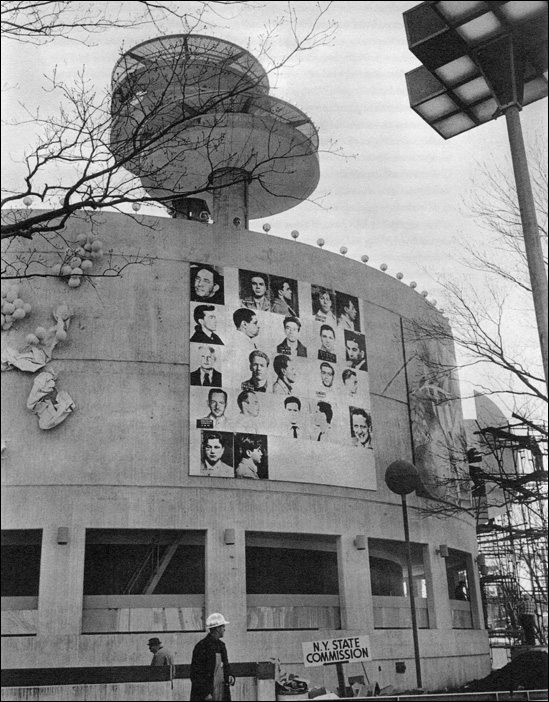
Photo reprinted from the exh. cat. for the "13 Most Wanted Men: Andy Warhol and the 1964 World's Fair" exhibition at the Queens Museum, NY (April 27 - September 7, 2014) and the Andy Warhol Museum in Pittsburgh (September 27, 2014 - January 5, 2015) - curated by Larissa Harris, Nicholas Chambers, Anastasia Rygle (Project Assistant Curator) and Timothy Mennel (Curatorial Adviser.)
Andy Warhol's mural, Thirteen Most Wanted Men, is often incorrectly referred to as the "10 Most Wanted Men." The 20 ft. by 20 ft. mural, consisting of large scale portraits of wanted criminals, was meant to grace the New York State Pavilion at the World's Fair of 1964 but was covered up with silver paint by the time the Fair opened. Individual portraits from the mural were later displayed and sold as separate works. The Pavilion, itself, was designed by Philip Johnson and Richard Foster Architects.
The confusion in regard to the title of Warhol's mural probably stems from it being referred to as the "10 Most Wanted Men" in comments made by Philip Johnson and others and the fact that the mural is called the "Ten Most Wanted Men" in Popism. Although Popism was written as though it was by Warhol, it was actually written by Pat Hackett from interviews with the artist and other sources. Of all the Warhol biographies, Popism and Victor Bockris' biography are probably the least accurate.
Warhol was friends with both Philip Johnson and his boyfriend David Whitney, but particularly Whitney, and visited them at Johnson's residence, The Glass House, in the winter of 1964-65. Photographer David McCabe accompanied them and took these photos of Warhol smoking a cigarette there.
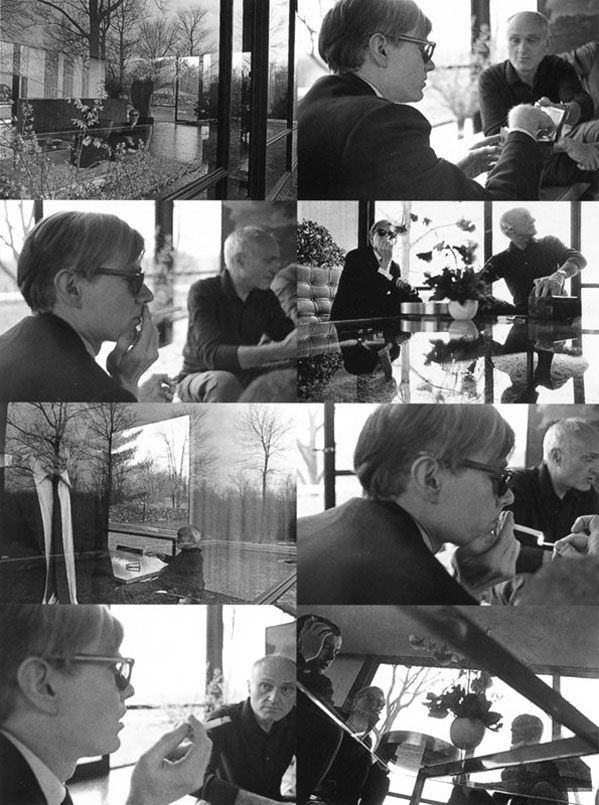
Andy Warhol smokes a cigarette at Philip Johnson's Glass House in New Canaan, Ct. (1964)
(Photos: David McCabe)
In interviews, Philip Johnson assumed that Warhol's images were based on the F.B.I.'s list of the Ten Most Wanted Fugitives. But they were actually lifted from the New York City Police Department's Thirteen Most Wanted. A pamphlet titled The Thirteen Most Wanted was found in one of Warhol's Time capsules and the images in the pamphlet correspond to Warhol's work. In an interview given in the New York Journal American newspaper, April 16, 1964, Warhol is quoted as saying "I got the pictures from a book the police put out It's called 'The 13 Most Wanted Men.'" (HA144) As noted in Vol. 2A of the cat. rais., "The World's Fair mural incorporated all twenty-two images of the Bulletin's thirteen men, but in a different order and arrangement..." (RNA025)
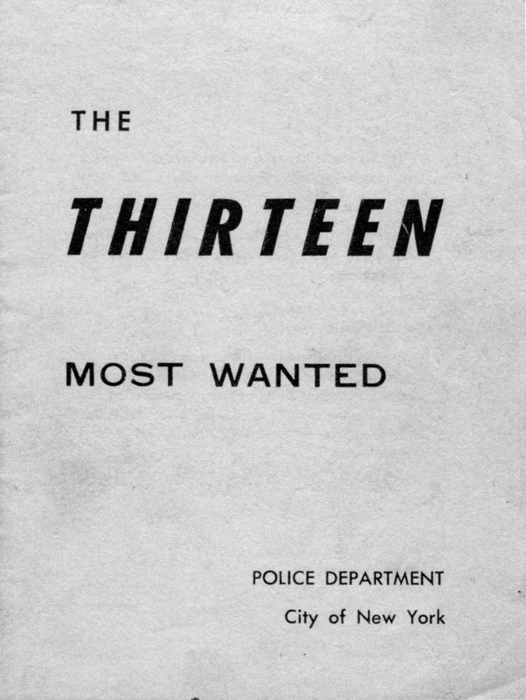
The Police Department pamphlet that was found in one of Warhol's Time Capsules.
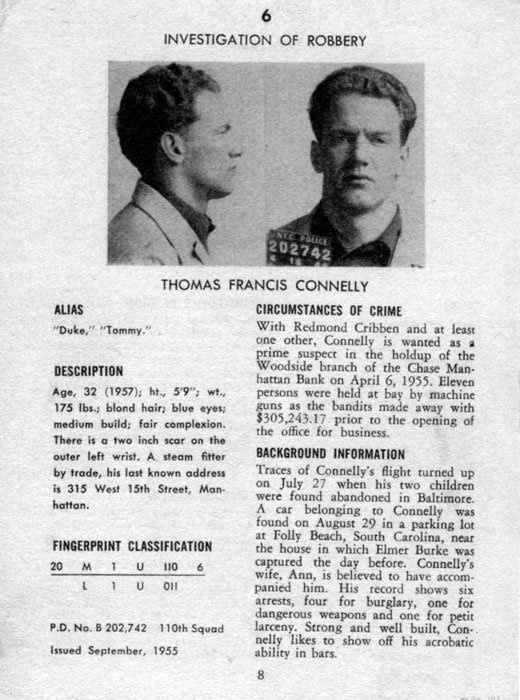
And one of the criminals in the pamphlet - Thomas Francis Connelly: "Strong and well built, Connelly likes to show off his acrobatic ability in bars."
Andy Warhol was just one of a number of artists commissioned to do works for the New York State Pavilion at the 1964 World's Fair. The Pavilion was the largest in the Fair and one of the few buildings to survive the dismantling of the Fair, albeit in a decaying state.
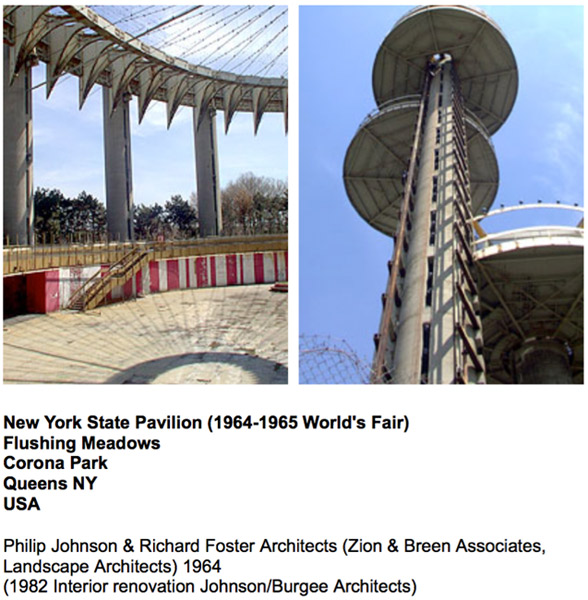
From Galinksky, here
The site was described in the following way in the Fair's 1964 Official Guide Book (here):
Looming over the New York State pavilion are three observation towers, one of which is the tallest structure at the Fair (226 feet). Beneath the towers is the Tent of Tomorrow, the world's biggest suspension roof (it is larger than a football field), supported by sixteen 100-foot concrete columns. Translucent colored panels in the roof flood the interior of the tent with colors. On the man floor, Texaco Oil Company has made a mammoth map of the state in terrazzo. Around the map are a number of attractions, including an exhibit by the New York State Power Authority, a fine arts gallery, fashion shows and an automat. On the mezzanine, visitors may have an opportunity to meet state legislators. Next to the Tent of Tomorrow is the Theaterama, a large, cylindrical movie theater decorated with controversial "pop" art.
*Admission: free to the pavilion; Observation Tower, adults 50 cents, children 25 cents; Theaterama, 25 cents.
Warhol worked on the silkscreens for the Thirteen Most Wanted Men for a considerable time. Three receipts for the screens have been found in the Warhol archives dated February 25, March 13 and March 16, 1964 and the Andy Warhol Catalogue Raisonné notes that "two documents in the Warhol archive that date from late 1962 and early 1963 indicate that the commission was somewhat earlier than is generally thought." (RNA024)
The 1962 document, "Amendments to State Architect's Standard Specifications,' was dated 26 December 1962 and indicated that eleven artists were originally chosen for the project "in collaboration with the Governor's New York State Council on the Arts." The cat. rais. identifies ten commissioned artists - Andy Warhol, Peter Agostini, John Chamberlain, Robert Indiana, Ellsworth Kelly, Roy Lichtenstein, Alexander Liberman, Robert Mallary, Robert Rauschenberg, and James Rosenquist, with a footnote indicating that "Claes Oldenburg was the eleventh artist" named in the 1962 document. Robert Indiana's mural, Eat, had the same title as Warhol's film of Indiana eating a mushroom which Warhol filmed in February 1964. (See: EAT) (AD290) (309) (RNA380n1)
A photograph of the architect, Philip Johnson, posing with some of the artists involved with the project was included in the February 1964 issue of Harper's Bazaar which announced on its front cover, "The Bazaar Look at the World's Fair."
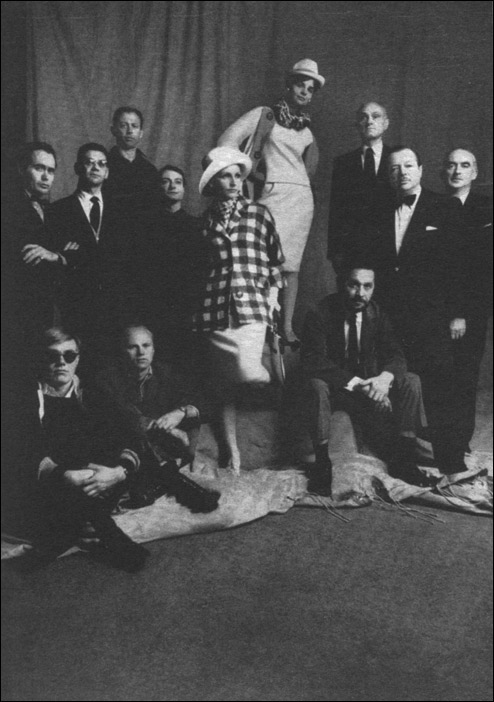
L to r: Andy Warhol, James Rosenquist, and Peter Agostini. Standing, l to r: Bob Indiana, Francisco C.J. Ferrer (not a Pavilion artist), Ellsworth Kelly, Roy Lichtenstein, Philip Johnson, Joe Mistier (not a Pavilion artist) and Alexander Liberman. (Photo: David Montgomery)
In 2014-15 an exhibition devoted to Warhol's Thirteen Most Wanted Men took place at the Queens Museum, NY (April 27 - September 7, 2014) and The Andy Warhol Museum, Pittsburgh (September 27, 2014 to January 5, 2015). Larissa Harris explored the reasons that the mural was painted over in the exhibition catalogue for the show. She quotes a conversation between Henry Geldzahler and Philip Johnson in which Johnson claims that it had to do with the fact that "9 of the 10 names were all from..." before he is interrupted by Geldzahler: "A certain part of the world." And Johnson continues "Yes! We, the Governor wanted to be elected...." (HA13)
The inference is that the Governor of New York wanted Warhol's mural removed because most of the men were Italian and the Governor needed the Italian vote "to be elected." Only seven of the thirteen men had Italian names rather than the 9 out of 10 names claimed by Johnson. (HA14)
It's difficult to know from Johnson's claim whether the Governor actually said that it was an election issue or if that was just the interpretation put on it by Johnson and Geldzahler. Other factors may also have come into play when the decision was made to remove the mural. Was emblazoning the NY State Pavilion with a group of criminal mug shots the best way to welcome visitors to New York? Did criminals represent what New York was all about? In an article titled "Some Not-So-Fair-Faces: Mural is Something Yegg-stra," (New York Journal-American, April 15, 1964), members of the public were interviewed about the mural and their comments were mostly negative. One person thought that "a painting with all those criminals" would "spoil some of the fun of the Fair" and "it should be brought down." Another member of the public is quoted as saying, "Thugs at the Fair? Nobody wants to see their distasteful pictures. Why not concentrate on beauty instead of criminals and crime?" (HA144-5) The newspaper also noted that the deputy commissioner of the Police Department's Bureau of Community Relations "didn't have any idea how Mr. Warhol got hold of the pamphlet used as a working plan for the work of art." (HA145)
In a letter to the New York State Dept. of Public Works, Division of Architecture, dated April 17, 1964 (two days after the article), Warhol wrote:
Gentlemen:
This serves to confirm that you are hereby authorized to paint over my mural in the New York State Pavilion in a color suitable to the architect.
Very truly yours,
Andrew Warhol
The typed letter is unsigned and is part of a exhibition, "Letters to Andy Warhol," which runs November 15 to December 26, 2016 at Cadillac House in New York before traveling to Los Angeles in mid-January 2017, Miami in early February 2017 and globally in early 2018.
The next day, on April 18, 1964, the New York Journal-American reported that not only did the Police Department dislike the mural, so did the artist. Under the heading, "Fair's 'Most Wanted' Mural Becomes 'Least Desirable'" the newspaper reported "The Police Dep't., it appears, is not the only group which looks with disfavor" on the mural. Warhol himself, according to the paper, did not like it: "Mr. Warhol yesterday told Philip Johnson, designer of the exhibit, he did not feel his work achieved the effect he had in mind, and asked that [it] be removed so he could replace it with another painting." (HA145)
There may also have been legal reasons to paint over the mural. Because the images came from the the list published by the local New York City Police and not the federal F.B.I.'s list, the criminals portrayed were local men with families. Grace Glueck reported in the New York Times on July 19, 1964 that Warhol had received "legal threats" from one of the subjects who had been pardoned. (RNA027)
Philip Johnson may have had a inkling that there would be problems with the mural before the press reports. On March 4, 1964, he had sent a telegram to Warhol at his home at 1342 Lexington Avenue, saying "Please don't take with reporters or give out any public statements on your work for the New York State exhibit. This will be handled by the Publicity Department of the New York State Commission." (HA56) It's unknown whether Johnson sent this out as general advice or because he thought there would be specific problems with Warhol's work.
In regard to the deputy commissioner's comment that he didn't know where Warhol obtained the source material, it apparently came from the boyfriend of Wynn Chamberlain - at least according to John Giorno who starred in Andy Warhol's film, Sleep.
John Giorno (You Got to Burn to Shine (London/NY: High Risk Books/Serpents Tail, 2001), pp. 127-129):
On April 28, 1963, Wynn Chamberlain invited Andy, me, and a friend of his named Bobo Keely, to dinner in his loft on the top floor at 222 Bowery. This was the first time I got to know Andy... Wynn cooked a gourmet dinner. We were going to the Judson Dance Theatre to see Yvonne Rainer's new piece, Terrain.
At dinner we talked about Bob Indiana's new show at the Stable and the current gossip. Andy mentioned he had a problem because he had to do a piece for the 1964 New York World's Fair and he didn't have an idea. Henry Geldzahler had selected twelve Pop artists to do works. Andy was asked to do something for the New York State Pavilion, a ten-sided building designed by Philip Johnson, and he had to do ten huge pictures for the top of each side. "Oh, I don't know what to do!" said Andy.
We were eating coq-au-vin and drinking white wine. Wynn said "Andy, I have a great idea for you. The Ten Most Wanted Men! You know, the mug shots the police issue of the ten most wanted men."
"Oh, what a great idea!" said Andy.
"My boyfriend is a cop," said Wynn. "He can get you all the mug shots you want. He brings a briefcase of them home every night... But I'm thinking of the Ten Most Wanted Men sheets they put in the post office every month."
"Oh, what a great idea!" said Andy. "But Robert Moses has to approve it or something... I don't care, I'm going to do it!"
Wynn Chamberlain had a lover, Jimmy O'Neill, who was gay and a New York City policeman, half Italian and half Irish, and he was gorgeous. Jimmy was a third-generation cop. His grandfather was a captain and his father was a captain. Jimmy was hip. He gave Andy a big manila envelope filled with crime photos, mug shots, archival photographs, and the Ten Most Wanted Men... There were hundreds of police photos in the envelope from Jimmy O'Neill. These photos also gave rise to some of the Disaster paintings.
Giorno's comments are similar to Philip Johnson's public comments, who also incorrectly referred to Warhol's work as the Ten Most Wanted Men. It's possible that some of Warhol's sources for his Disaster paintings were from the manila envelope. Warhol's source for Black and White Disaster (c. early 1963) has never been found and the source for his car crash disasters include an unidentified newspaper photograph and a UPI photograph that could have been in the envelope. It's impossible to say with certainty.
The New York Times announced Warhol's Thirteen Most Wanted Men in an article published on October 5, 1963.

New York Times, October 5, 1963
Before the images were painted over with silver paint, one option apparently considered was to replace them with serial portraits of Robert Moses, the head of the corporation that was formed to produce the Fair. Warhol did produce large portraits of Moses but their whereabouts are unknown.
From the Andy Warhol Catalogue Raisonné (Vol. 2A):
An aerial view in Newsday, dated April 21, shows Warhol's mural covered by a dark tarp... Although the tarp was temporary, the silver monochrome of the painted-over mural seems to have remained on the facade at least through the summer. Mark Lancaster, visiting from England and assisting Warhol in the studio in July and August, has recalled seeing it in that state, when he accompanied Warhol to the fair in mid-July. According to Lancaster, Warhol produced an alternative subject not long after, a portrait of Robert Moses, the controversial president of the World's Fair Corporation; it was judged to be unacceptable as well. Subsequently, the Moses panels were lost or destroyed... (RNA026)
Warhol later exhibited the Most Wanted series on canvas at exhibitions in Paris, Cologne and London.
From the Andy Warhol Catalogue Raisonné (Vol. 2A):
[Mark] Lancaster has also remembered stretching a series of canvases printed with the faces of the Most Wanted Men in early July. This indicates that Warhol probably produced the series of paintings some time between late April and the end of June, in the aftermath of the mural. The same screens were used for the paintings and the panels of the mural... In late September 1964, when Warhol joined the Leo Castelli Gallery, eight canvases were recorded in the gallery registry... According to the registry, these canvases were consigned to Ileana Sonnabend in May 1966, a year before they were exhibited at her Paris gallery... The catalogue of the Sonnabend exhibition in Paris is not dated, but contemporary reviews place it between February 26 and May 7, 1967... The Sonnabend exhibition traveled to Galerie Rudolf Zwirner, Cologne, where it was on view in September and October, and to the Rowan Gallery, London, in March 1968. (RNA026)
[end]
Gary Comenas, 2016
warholstars.org